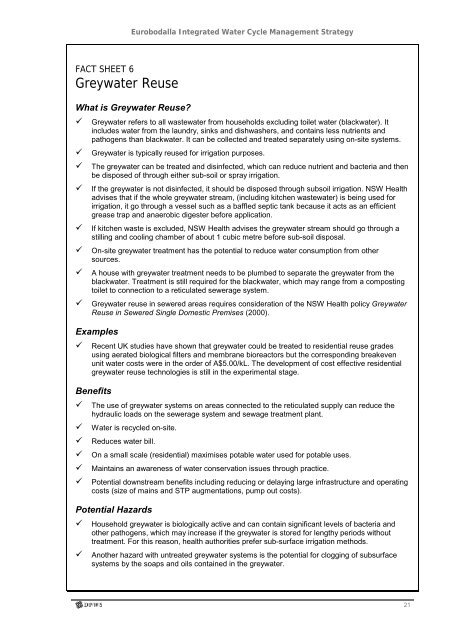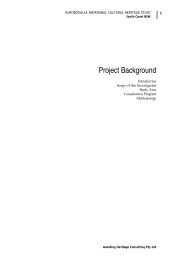Eurobodalla Integrated Water Cycle Management Strategy
Eurobodalla Integrated Water Cycle Management Strategy
Eurobodalla Integrated Water Cycle Management Strategy
You also want an ePaper? Increase the reach of your titles
YUMPU automatically turns print PDFs into web optimized ePapers that Google loves.
FACT SHEET 6<br />
Greywater Reuse<br />
<strong>Eurobodalla</strong> <strong>Integrated</strong> <strong>Water</strong> <strong>Cycle</strong> <strong>Management</strong> <strong>Strategy</strong><br />
What is Greywater Reuse?<br />
Greywater refers to all wastewater from households excluding toilet water (blackwater). It<br />
includes water from the laundry, sinks and dishwashers, and contains less nutrients and<br />
pathogens than blackwater. It can be collected and treated separately using on-site systems.<br />
Greywater is typically reused for irrigation purposes.<br />
The greywater can be treated and disinfected, which can reduce nutrient and bacteria and then<br />
be disposed of through either sub-soil or spray irrigation.<br />
If the greywater is not disinfected, it should be disposed through subsoil irrigation. NSW Health<br />
advises that if the whole greywater stream, (including kitchen wastewater) is being used for<br />
irrigation, it go through a vessel such as a baffled septic tank because it acts as an efficient<br />
grease trap and anaerobic digester before application.<br />
If kitchen waste is excluded, NSW Health advises the greywater stream should go through a<br />
stilling and cooling chamber of about 1 cubic metre before sub-soil disposal.<br />
On-site greywater treatment has the potential to reduce water consumption from other<br />
sources.<br />
A house with greywater treatment needs to be plumbed to separate the greywater from the<br />
blackwater. Treatment is still required for the blackwater, which may range from a composting<br />
toilet to connection to a reticulated sewerage system.<br />
Greywater reuse in sewered areas requires consideration of the NSW Health policy Greywater<br />
Reuse in Sewered Single Domestic Premises (2000).<br />
Examples<br />
Recent UK studies have shown that greywater could be treated to residential reuse grades<br />
using aerated biological filters and membrane bioreactors but the corresponding breakeven<br />
unit water costs were in the order of A$5.00/kL. The development of cost effective residential<br />
greywater reuse technologies is still in the experimental stage.<br />
Benefits<br />
The use of greywater systems on areas connected to the reticulated supply can reduce the<br />
hydraulic loads on the sewerage system and sewage treatment plant.<br />
<strong>Water</strong> is recycled on-site.<br />
Reduces water bill.<br />
On a small scale (residential) maximises potable water used for potable uses.<br />
Maintains an awareness of water conservation issues through practice.<br />
Potential downstream benefits including reducing or delaying large infrastructure and operating<br />
costs (size of mains and STP augmentations, pump out costs).<br />
Potential Hazards<br />
Household greywater is biologically active and can contain significant levels of bacteria and<br />
other pathogens, which may increase if the greywater is stored for lengthy periods without<br />
treatment. For this reason, health authorities prefer sub-surface irrigation methods.<br />
Another hazard with untreated greywater systems is the potential for clogging of subsurface<br />
systems by the soaps and oils contained in the greywater.<br />
21

















